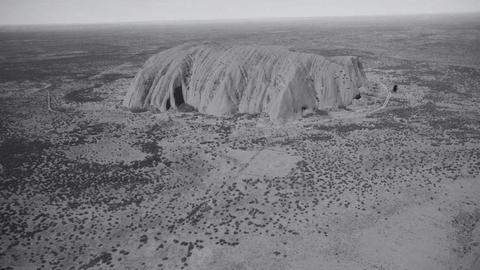26th October 1985: Uluru is Returned to Traditional Owners

The whole world seemed to know it as “Ayers Rock”, but to the Anangu people, it’s Uluru. The Anangu people are the traditional landowners of Uluru and they have been passing down knowledge on how to care for Uluru for generations.
On the 26th of October 1985, the land that was claimed by the Northern Territory Government was returned to its rightful owners: the Anangu people. In this blog, we will look at the back at their towards reclaiming the sacred land of Uluru-Kata Tjuta National Park.
What is Uluru ?
Uluru is a red sandstone monolith that is 348 metres high. It is one of the most known landmarks of Australia, and is situated at the heart of the nation, physically and culturally. It is a tourist hotspot because it is the most recognisable feature of the outback.
To the Anangu people they believe that their culture existed in and around Uluru and Kata Tjuta in Central Australia and from the beginning the landscape was created by ancestral beings. There is evidence that for over 10000 that events such as ceremonies and rites of passage have been performed here.
The preservation of the areas surrounding Uluru and Kata Tjuta are regarded as core Anangu duties.
History

William Gosse was the first known European to see and climb Uluru. Sir Henry Ayers, the Chief Secretary of South Australia, inspired him to give it the name Ayers Rock in 1873.
In the 1890s, a group of scientists examined the region's geology, mineral resources, vegetation, wildlife, and Aboriginal culture and concluded that farming was not feasible there.
Beginning in 1920, Uluru and Kata Tjuta were a part of the South West Reserve, a network of areas reserved for Aboriginal people.
Not until 1948 was the first road to Uluru constructed. It attracted tourists and miners, and in 1950 Ayers Rock National Park was established. As tourism increased over time, a new airstrip was constructed to accommodate arriving visitors.
The Ayers Rock-Mount Olga National Park, administered by the Northern Territory Reserves Board, was expanded to include Kata Tjuta in 1958. Although many Anangu people continued to travel around their homelands, they were discouraged from accessing the park.
Fighting for Rights to Uluru
Many Anangu were inspired to return to their homeland following the Wave Hill Walk-Off in 1966. They advocated for the rights to their lands before the Northern Territory Government. They voiced their worries about the negative consequences of mining, pastoralism, tourism, and vandalisation of sacred places.
The Northern Territory Government refused to acknowledge the rights of the traditional owners despite persistent campaigning. With a limited claim for the Anangu and no involvement in park management, it wanted title transferred from the Commonwealth to the territory. When it was named Uluru-Kata Tjuta (Ayers Rock-Mount Olga) National Park in 1977, the region was not covered by the Aboriginal Land Rights Act of 1976.
The dispute persisted until the 1983 election of the Hawke administration. The Aboriginal Land Rights Act would be changed, and the Anangu would receive ownership of the Uluru-Kata Tjuta National Park. It was revealed in November of that year.
It was the focal point of a ceremony held on the 26th of October 1985, to hand over the rights of Uluru and Kata Tjuta to their Anangu traditional owners. The ceremony, held beneath Uluru and is still remembered as one of the turning points in the fight for Aboriginal land rights. Uluru's significance for both Indigenous and non-Indigenous Australians was acknowledged by the time's, governor general, Sir Ninian Stephen. A majority of Anangu members made up the board of directors and the park is still managed collaboratively.
What This Means to First Nations People
The handover, which Central Land Council director David Ross termed "groundbreaking," symbolised a growing understanding of Aboriginal customary law and land rights that eventually led to the 1993 passage of the Native Title Act by the Federal Parliament.
For many people, Uluru and its neighbour Kata Tjuta are more than just beautiful landmarks. They are profoundly sacred living cultural landscapes. Handing back Uluru to its original owners makes a big impact to First Nations people. It recognises their rights as traditional owners of the land; rights that should be intrinsic in the first place. Land rights are essential in order to address historical injustices and reduce social and economic inequality. It's also for long term preservation of the earth.
We can take inspiration from the way Anangu people fought for their rights to Uluru.
Why We Don't Climb on Uluru
Climbing Uluru has long been considered a violation of *Tjukurpa by the Anangu. There are many problems associated with climbing Uluru.
One it's dangerous, more than 30 people have died while climbing Uluru throughout the years, and many more have required rescue. Two, too many people climbing up cause erosion and pollution. Three, species within Uluru became nearly extinct. Last and most important of all, Uluru is sacred to the Anangu people. Supposedly, only initiated men are allowed to climb Uluru. It is very important to respect this.
In 2010, the Uluru-Kata Tjuta Plan of Management stated that when less than 20% of visitors make the climb, the board would consider permanently closing the climb. By 2015, only 16.5 percent of people were climbing. The board unanimously decided in November 2017 to prohibit the ascent beginning in October 2019.
Precisely 34 years after the government formally handed the lands to the Anangu, the Uluru climb was permanently shut down.
*the creation period when ancestral beings, Tjukuritja, created the world as we know it.



